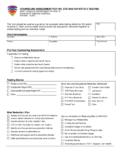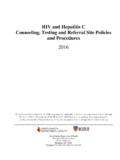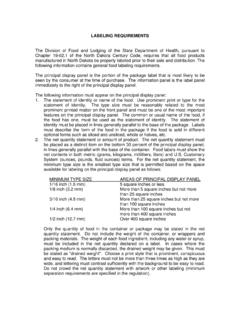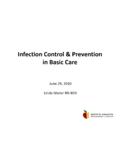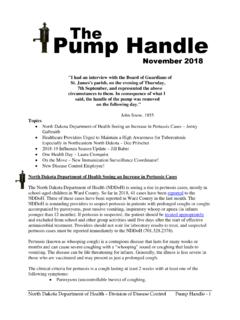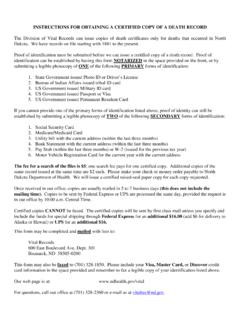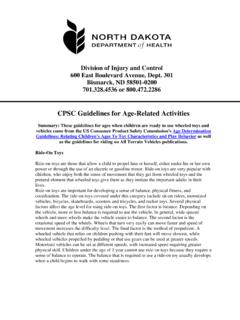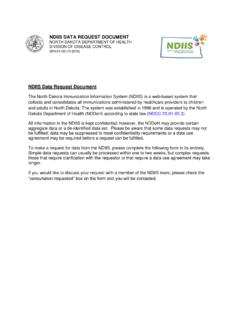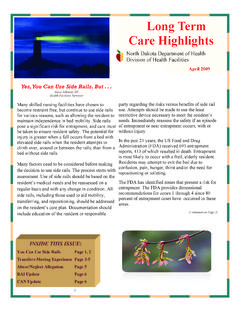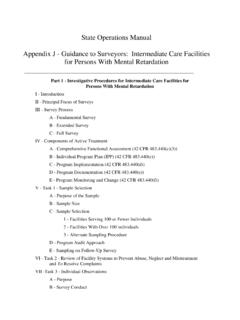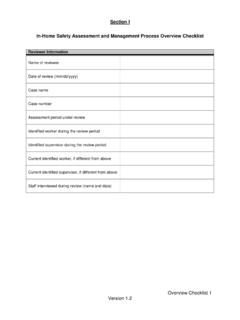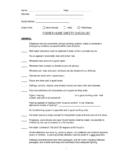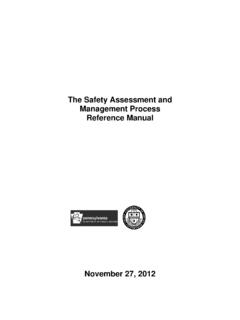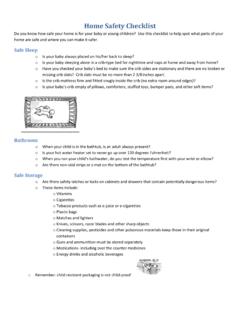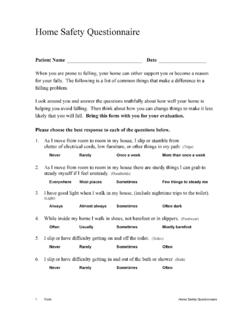Transcription of HOME SAFETY CHECKLIST - North Dakota Department of …
1 home SAFETY CHECKLIST . Are Children Safe in Your home ? 2017. North Dakota Department of health Division of Injury and Violence Prevention For more information, call or Table of Contents 3. 4. 6. Common Child 8. Garage and Yard .. 12. General 14. SAFETY 19. A Message from the State health Officer Mylynn Tufte, MBA, MSIM, BSN. North Dakota Department of health I'm grateful for the opportunity I've been given to be a mother, caregiver, and the State health Officer for North Dakota . We live in a fast-paced and demanding world where it's hard to slow down and find time to focus on what may seem to be small details. That's why I encourage you to use this important home SAFETY CHECKLIST to discover and fix any hazards that may endanger your children. Too many children are injured each year in North Dakota , and many of those injuries occur in homes where children should be safe to grow up strong and healthy.
2 If you have any questions, feel free to call the injury prevention professionals at the North Dakota Department of health . We are here to help. Preface The home is the second most common location of unintentional fatal injuries in the United States. The rates for injuries occurring in the home are highest among young children compared to other age groups. About 2 million children are injured or killed due to hazards in the home each year. Their stages of physical development make them vulnerable population groups for fatal injury. Children may become injured while engaging in normal exploratory behaviors, lacking the judgment to avoid dangers. They often experience more home injuries, in part because they spend more time in the home environment, compared to other age groups who spend large amounts of time at school and/. or work. The good news is that many of these incidents can be prevented by identifying and correcting the hazard.
3 Use this CHECKLIST as a guide to go through your home and look for potential risks. If you find hazards in the home using this CHECKLIST , take care of the hazards right away to eliminate injuries. Please note this CHECKLIST may not represent all of the potential hazards in your home but includes most of the common dangers found in a child's environment. To check for SAFETY or product recalls, contact the Consumer Product SAFETY Commission This CHECKLIST cannot stand alone because active supervision is one of the best tools for injury prevention. 3. KITCHEN. KITCHEN. 1. Are sharp items, such as knives and scissors, Y N. stored in a cabinet or drawer with a SAFETY latch or lock? Keep sharp items out of children's reach. Chil- dren are curious and like to investigate closed drawers. Install SAFETY latches or locks on cabi- nets or drawers. 2. Are vitamins and medicines stored out of sight Y N.
4 Or reach of children? Pills sometimes look like candy, and children can become sick or overdose on medicines. Store in locked cabinets or drawers and not on countertops, even when people are visiting. 3. Are household products such as cleaning Y N. supplies, dishwashing compounds or drain cleaners stored in cabinets with SAFETY latches or locks or out of the reach of children? Look around your home under the sinks and in the garage for cleaning products or automotive fluids that say Caution, . Warning or Danger on the label. Store these items away from food and in locked cabinets out of the sight and reach of children. Keep the poison control center toll-free number by every phone in the house, Have the children's current weight available if a call to the Poison Control Center is needed. Post it in an obvious place for all caregivers. 4. Are all flammable items away from range or oven? Y N.
5 Remove any towels or combustible items in the space surrounding the cooking area. 4. 5. Do you take these precautions while cooking? Y N. Turn pot handles toward the back of the stove. KITCHEN. Stay in the kitchen at all times when food is cooking on the stove. Use protective dials made for stoves if children can reach the knobs. Keep hot liquids out of the reach of children. Use the back burners whenever possible. Unplug small appliances and put them away when not in use. Make sure the microwave is out of the reach of children. They can easily open the microwave door and remove hot contents, which could be a burn hazard. Never heat a baby's bottle in the microwave. 6. Does your high chair have a waist and a crotch Y N. strap? While in the high chair, babies always should be restrained by both straps. 5. BATHROOM. 1. Are medicines and vitamins stored out of a Y N. child's reach or in a cabinet with a SAFETY latch or lock?
6 Make sure houseguests keep their medicines out of reach, as well. 2. Are electrical appliances (radio, hair dryer, Y N. curling iron, space heater) used away from water, BATHROOM. out of a child's reach, and unplugged after each use? Many children do not understand the dangers of electrocution and could possibly play with electrical appliances if they are in reach. Ensure hair dryers have built-in shock protection devices in the plug. 3. When children are in the bathtub, does an adult Y N. always watch them? Supervise children in the tub at all times. Avoid leaving the bathroom for quick errands, such as answering the phone or the door, doing laundry, etc. Children can drown in a few inches of water or can be burned if they turn on the hot water. Never, even for a moment, rely on bath rings or seats to keep baby safe in water. 4. Does the bathtub or shower have a nonskid mat Y N. or strips on the standing area?
7 Nonskid mats or strips help prevent slippery sur- faces, decreasing the chances of a child slipping. 6. 5. Is the hot water adjusted to 120 degrees or less Y N. to prevent tap water scalds? Let water run for three to five minutes before testing it. Use a meat or candy thermometer to test the tem- perature in a glass of hot water from your tap. Your hot water temperature is _____. degrees. 6. Are sharp or dangerous objects stored out of a BATHROOM. Y N. child's reach? Nail scissors, tweezers and razors can be very hazardous in small hands. Store them in a locked location out of the reach of children. 7. Are toilet lids always closed? Y N. Children who can pull themselves to a standing position (around 7 months) can fall head first into an open toilet and drown. You may want to consider devices that lock your toilet lid to keep baby from opening it. 8. Are doors kept closed for additional child Y N.
8 Proofing? Doorknob locking devices are available to keep children from opening doors and entering rooms they are not supposed to enter. 9. Are countertops and/or vanities free from sharp Y N. corners? Corner bumpers are recommended for sharp edges and are available at stores. 10. Is your trash can covered with a lid? Y N. Children are curious and will reach for items in the trash. 7. COMMON CHILD AREAS. 1. Do windows have screens that are secure or Y N. window guards to keep a child from falling out? Window guards and SAFETY netting for balconies and decks can help prevent serious falls. There should be no more than 4 inches between the bars of the window guard. 2. Are toys free from loose parts, sharp edges or Y N. points, long cords, and lead? Make sure toys are age appropriate. For example, some toys may be too small for infants, and they may put them into their mouth and choke. 3. Does the toy chest have either a lightweight lid, Y N.
9 No lid or a slow-closing lid? COMMON CHILD AREAS. A dropping lid can cause injury to the head and neck, or it may cause suffocation. 4. Can air get in when the toy chest is closed? Y N. Airtight containers can cause suffocation. 5. Are open buckets of liquids out of reach of Y N. children? Children who can pull themselves to a standing position (around 7 months) can fall head first into an open bucket and drown. 6. Are bookshelves anchored to the wall? Y N. Young children can be injured when furniture tips over. Children often try to climb furniture. 7. Are bunk beds without corner posts? Y N. Children may get hung up on corner posts and suffocate. 8. 8. Are electrical cords beyond a child's reach? Y N. Children can pull electrical cords, and the equipment could fall on them. Consider using an electric wire guard to hide cords. Move furniture to hide electric cords and to keep them out of reach.
10 9. Do you have shock prevention plugs or covers Y N. on unused electrical outlets? Be sure the outlet protectors cannot be removed easily by children and are large enough so that children cannot choke on them. 10. Does the bunk bed mattress fit the bed frame Y N. completely? Too much spacing around the bunk beds may COMMON CHILD AREAS. create entrapment areas where children can get caught and suffocate. 11. Is the bunk bed spacing between the bed Y N. frame and the bottom of guardrails no greater than 3 1/2 inches? Too much spacing around the bunk beds may create entrapment areas where chil- dren can get caught and suffocate. A. child's body may fit through the slots but his head may become trapped. 12. Does your crib have a drop-side rail? Y N. Check to see if the crib is recalled. Stop using the drop-side function. Check to see if the crib manufacturer offers an immobilizer for the rail.
